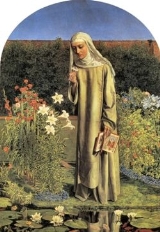
Convent Thoughts
Encyclopedia
Convent Thoughts is a painting by the Pre-Raphaelite painter Charles Allston Collins
which was created between 1850 and 1851. Collins sent it to the Royal Academy of Arts in 1851 where it was exhibited.
The painting shows a nun contemplating a passion flower
symbolising the crucifixion of Christ. She is standing in a walled garden full of minutely detailed flowers. In her left hand she holds an illuminated missal
, held not as though she had been reading it but so as to show us the Annunciation and the Crucifixion. Her costume shows that she is a novice, presumably meditating on her final vows.
The flowers were painted in the Oxford garden of Thomas Combe
, an early collector of Pre-Raphaelite paintings. Combe bought the painting; in 1894 he bequeathed his art collection to the Ashmolean Museum
, Oxford
and Convent Thoughts remains in the Museum's collection to the present day.
Although Collins was never formally a member of the Pre-Raphaelite Brotherhood, he was in sympathy with their aims and painted in their immensely detailed style. Convent Thoughts has a place in the history of Pre-Raphaelitism, because the tide of opinion, initially hostile, was to some extent turned by a letter to The Times
on 13 May 1851 from the influential critic John Ruskin
praising the Pre-Raphaelite paintings at the Academy exhibition, in particular Convent Thoughts, about which he wrote:
In a curious footnote to this story, it has recently been pointed out that there is in fact no Alisma Plantago
in the picture.
Charles Allston Collins
thumb|Convent Thoughts by CollinsCharles Allston Collins was a British painter, writer and illustrator associated with the Pre-Raphaelite Brotherhood.-Early years:...
which was created between 1850 and 1851. Collins sent it to the Royal Academy of Arts in 1851 where it was exhibited.
The painting shows a nun contemplating a passion flower
Passion flower
Passiflora, known also as the passion flowers or passion vines, is a genus of about 500 species of flowering plants, the namesakes of the family Passifloraceae. They are mostly vines, with some being shrubs, and a few species being herbaceous. For information about the fruit of the passiflora...
symbolising the crucifixion of Christ. She is standing in a walled garden full of minutely detailed flowers. In her left hand she holds an illuminated missal
Missal
A missal is a liturgical book containing all instructions and texts necessary for the celebration of Mass throughout the year.-History:Before the compilation of such books, several books were used when celebrating Mass...
, held not as though she had been reading it but so as to show us the Annunciation and the Crucifixion. Her costume shows that she is a novice, presumably meditating on her final vows.
The flowers were painted in the Oxford garden of Thomas Combe
Thomas Combe
Thomas Combe was a printer, publisher and patron of the arts. He was 'Printer to the University' at Oxford University Press, and was also a founder and benefactor of St Barnabas Church, near the Press in Jericho and close to Oxford Canal....
, an early collector of Pre-Raphaelite paintings. Combe bought the painting; in 1894 he bequeathed his art collection to the Ashmolean Museum
Ashmolean Museum
The Ashmolean Museum on Beaumont Street, Oxford, England, is the world's first university museum...
, Oxford
Oxford
The city of Oxford is the county town of Oxfordshire, England. The city, made prominent by its medieval university, has a population of just under 165,000, with 153,900 living within the district boundary. It lies about 50 miles north-west of London. The rivers Cherwell and Thames run through...
and Convent Thoughts remains in the Museum's collection to the present day.
Although Collins was never formally a member of the Pre-Raphaelite Brotherhood, he was in sympathy with their aims and painted in their immensely detailed style. Convent Thoughts has a place in the history of Pre-Raphaelitism, because the tide of opinion, initially hostile, was to some extent turned by a letter to The Times
The Times
The Times is a British daily national newspaper, first published in London in 1785 under the title The Daily Universal Register . The Times and its sister paper The Sunday Times are published by Times Newspapers Limited, a subsidiary since 1981 of News International...
on 13 May 1851 from the influential critic John Ruskin
John Ruskin
John Ruskin was the leading English art critic of the Victorian era, also an art patron, draughtsman, watercolourist, a prominent social thinker and philanthropist. He wrote on subjects ranging from geology to architecture, myth to ornithology, literature to education, and botany to political...
praising the Pre-Raphaelite paintings at the Academy exhibition, in particular Convent Thoughts, about which he wrote:
"I happen to have a special acquaintance with the water plant Alisma Plantago ... and as I never saw it so thoroughly or so well drawn, I must take leave to remonstrate with you, when you say sweepingly that these men 'sacrifice truth as well as feeling to eccentricity.' For as a mere botanical study of the Water Lily and Alisma, as well as of the common lily and several other garden flowers, this picture would be invaluable to me, and I heartily wish it were mine."
In a curious footnote to this story, it has recently been pointed out that there is in fact no Alisma Plantago
Alisma
Alisma is a genus of flowering plants in the family Alismataceae, members of which are commonly known as water-plantains. The genus consists of aquatic plants with leaves either floating or submerged, found in a variety of still water habitats around the world . The flowers are hermaphrodite, and...
in the picture.

